Speech Understanding Rising Housing Loan Arrears
Thank you to the Property Council for asking me to speak at this Property Leaders' Summit. I want to address an important issue for the property industry – the rising rate of housing loan arrears (Graph 1). Why is it that an increasing share of housing borrowers are behind in their mortgage repayments? Mortgage arrears can be associated with significant personal trauma for borrowers. They also point to a rising risk to the financial system as housing loans are 40 per cent of banks' assets. If the value of the property backing the loan exceeds the value of the loan then arrears won't have a big impact on banks' profits or capital. But with falling housing prices the potential for banks to experience losses increases. So, on several fronts, this is an important issue.
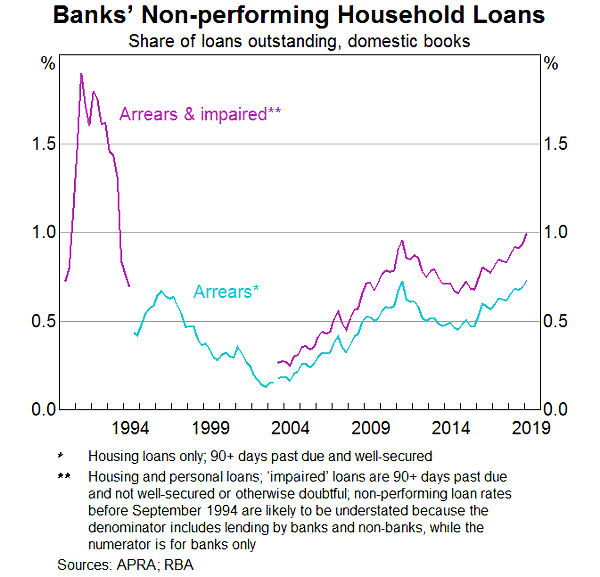
There are many reasons why borrowers fall into arrears, almost all of which involve a fall in income or rise in expenses – or both. Some borrowers experience personal misfortune, such as ill health or a relationship breakdown, which is unrelated to economic conditions or the quality of their loan. And even in good times, some people become unemployed. So there will always be some borrowers who fall into arrears.
However, it is weak economic conditions that drive cyclical upswings in arrears. In particular, borrowers can struggle to make their payments if their income falls. Weak conditions in housing markets make it hard for borrowers to get out of arrears by selling their property. Conversely, large increases in interest rates, say to slow an overheating economy, can also contribute to rising arrears.
Banks' lending standards also play a role in arrears. And it is important to note that economic conditions and lending standards interact. Poorer quality loans might continue to perform well in good economic conditions, and only fall into arrears with an economic downturn. In contrast, good quality loans will be more resilient in a downturn.
Because of the interaction between the various drivers of arrears, we often cannot point to a single cause of rising arrears. Today I want to discuss the ways in which economic conditions and lending standards are pushing arrears rates higher.
How High Are Arrears?
But first, it's worth pausing to compare some benchmarks for the level of arrears. The share of banks' housing loans in arrears is now back around the level reached in 2010, the highest it has been for many years. But arrears are still well below the level reached in the early 1990s recession.[1]
While the increase in arrears and its level is notable, the rate of arrears in Australia is still relatively low internationally, and in an absolute sense. The available data indicate that arrears are lower in Australia than in many other advanced economies (Graph 2). Indeed, another way to look at the arrears rate in Australia is to note that over 99 per cent of housing loans are on, or ahead of, schedule. Making loans involves risk, and banks are used to managing this risk. If the arrears rate was persistently very low, that would suggest that lenders were being too cautious in lending. In that world, some people who could almost certainly repay a loan would struggle to get one.
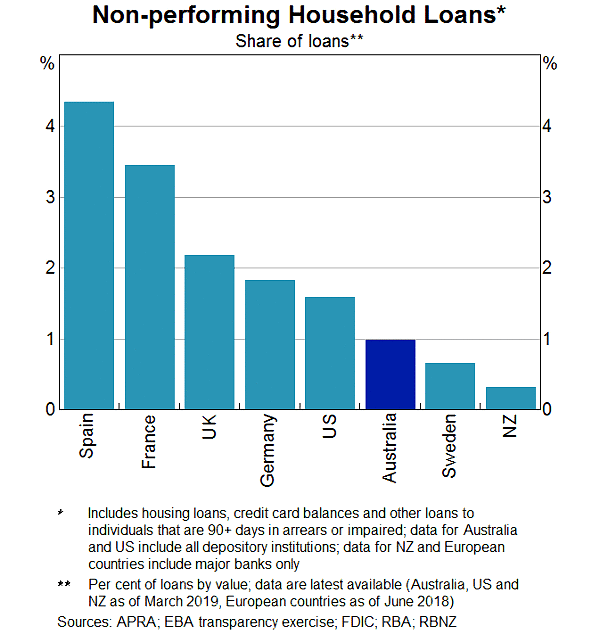
Borrower Income
So what drives arrears? Income is a major determinant of whether borrowers can meet their repayments. Strong employment growth for a number of years now has seen the unemployment rate decline. On the surface, this makes it surprising that rates of arrears have been rising. But the relationship between unemployment, income and arrears isn't straightforward.
One factor at play is that, while the unemployment rate has declined nationally, this hasn't been the case everywhere. What we can see across Australia is there is a clear pattern of more loans going into arrears in locations where the unemployment rate is higher (Graph 3). Notably the unemployment rate has increased and income growth slowed in Western Australia and parts of Queensland with the end of the mining boom. These areas have seen larger increases in arrears. In Western Australia the arrears rate is now around double the rate in the rest of the country. But the flow of loans into arrears in these regions is more than would be suggested by the unemployment rate alone.
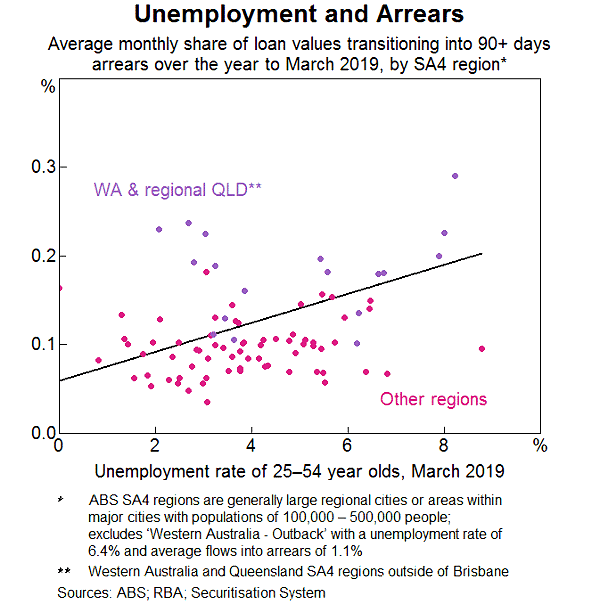
Indeed, rising unemployment in some areas can't be the whole story. As I said, the national unemployment rate has declined in recent years. So, when it comes to arrears, falling unemployment in some regions has not compensated for rising unemployment in others. One explanation is that it can matter who becomes unemployed and who gains a job. People aged in their thirties and forties are more likely to have a mortgage, particularly if they have good employment prospects. So, if more of them become unemployed, arrears rates will rise. Conversely, if it is older or younger workers who get a job, but don't have a mortgage, or second income earners in households already comfortably making their repayments, this won't lead to a decline in arrears rates.
The length of unemployment can also influence arrears. Around two-thirds of borrowers have accumulated buffers of prepayments of their mortgage, and some others have other assets outside of their property. Households with financial buffers can withstand some period of unemployment, but if that extends too long and depletes their savings, they risk falling into arrears.
There are several other reasons why focusing on unemployment doesn't tell the full story. It isn't that all borrowers either receive income or don't. Often borrowers may lose some of their income, say because of reduced work hours, a smaller bonus or because tenants move out of their investment property. When they don't have a large income or savings buffer, even small income falls or an unexpected increase in expenditure can put borrowers into arrears. Indeed in Western Australia where arrears have increased most, rental property vacancy rates have been high, reducing the income of landlords.
The rate of growth of income can play a role too. When nominal income is rising strongly, over time, mortgage payments take up a declining share of a borrower's income. As their mortgage ages and their income rises, borrowers are better placed to withstand a fall in their income or rise in expenses. Over the past five years, nominal income growth has been around half its longer-run average.[2] So, rising income hasn't been able to compensate for other factors that might cause households to struggle to make their mortgage repayments.
Housing Prices
Another recent feature of arrears is that, on average, mortgages are staying in arrears for longer. There are several possible explanations for this. Mortgages can leave arrears because the lender takes possession of the property and sells it. However, the number of repossessed mortgaged properties is very small and if anything has risen slightly, so this can't explain longer loan arrears.
Alternatively, borrowers can leave arrears by selling their property and repaying the loan.[3] In a strong housing market it is easy for borrowers struggling to make repayments, or already in arrears, to sell their property. In a strong housing market, it doesn't take long to sell a property at an attractive price. The owner is also likely to have had several years of price growth, increasing their equity. So if they sell they are better placed to pay off their mortgage and still have some of their savings.
But nationally prices have fallen 8 per cent from their peak, auction clearance rates and volumes have declined, and properties are taking longer to sell. In this environment, borrowers who fall into arrears find it harder to sell their property and repay their loan (Graph 4). Indeed, across the country, we see there is a strong relationship between recent housing price growth and the rate at which borrowers are leaving arrears. In those locations where housing price growth has been weaker, a smaller share of borrowers transition out of arrears.
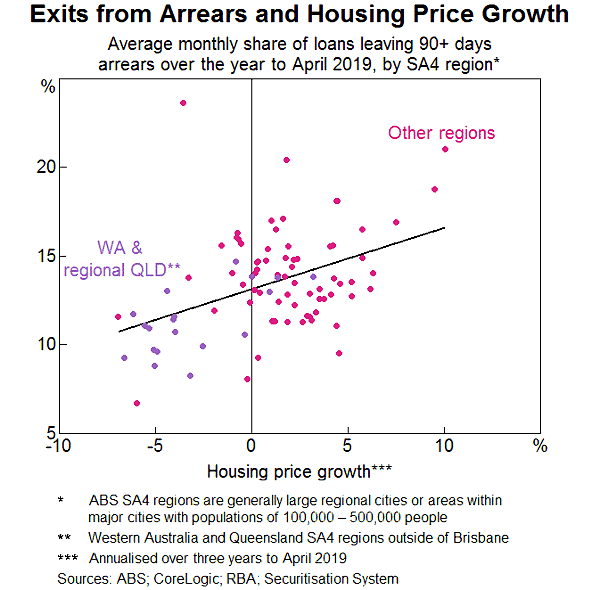
Other Economic Factors
The weaker housing market has also seen housing credit growth slow. Because loans tend to take some time to go into arrears, this has the effect of reducing the number of new loans that have repayments on schedule, and so increases the overall arrears rate. But our estimates suggest that slower credit growth accounts for less than one-tenth of the increase in the arrears rate since early 2016.
Another driver of arrears can be changes in interest rates. In the period before the GFC, arrears rates were rising despite strong economic conditions, in part because of large increases in mortgage interest rates. However, in recent years, interest rates on outstanding mortgages have been declining and so average mortgage interest rates have not contributed to the generalised increase in arrears.
Lending Standards
Lending standards are also an important driver of arrears rates. Weaker lending standards mean that borrowers can get larger loans and more borrowers get loans with potentially riskier characteristics, such as interest only periods. For a borrower, the larger their required loan repayments relative to their available income, the slower they will be able to build up a buffer, and so the more likely they are to fall into arrears if their income falls or expenses rise. With weaker lending standards, more loans will be made to borrowers who are likely to experience difficulty repaying their loan, say because their income is less stable. For these reasons, weaker lending standards can lead to higher rates of arrears.
In Australia there has been a significant tightening of housing lending standards by the regulators of banks and other lenders, in earnest from around 2014. Regulators took these actions amid concerns that strong housing market conditions and strong competition by lenders had seen lending standards erode. The actions taken by the Australian Prudential Regulation Authority (APRA) included that banks apply more stringent interest rate buffers to maximum loan size calculations, increase their scrutiny of borrowers' income and expenses, and reduce their share of lending with high loan-to-valuation ratios (LVRs). Complementing this, the Australian Securities and Investments Commission (ASIC) increased their focus on lenders' compliance with responsible lending obligations, particularly in the area of interest-only lending.[4] These actions were designed to ensure that lenders only extend as much debt to borrowers as they will be able to repay, including a buffer.
Tighter lending standards should lead to lower arrears but this can take time to show up. Typically borrowers' financial pressures build over time and so average arrears rates increase with time since loan origination, that is with ‘loan seasoning’.[5] For example, a three-year old loan is four times more likely to go into arrears than a one-year old loan. Another challenge of assessing the impact of lending standards on arrears is that different cohorts of loans experience common macroeconomic conditions at different times in their seasoning. If there is a sharp increase in unemployment in a given year, the cohort of loans originated one year earlier experience this with only 12 months of seasoning, while the cohort originated three years earlier experience it with 36 months of seasoning. This suggests that more recent loans would likely have a larger increase in arrears in response to rising unemployment.
Using the Reserve Bank's Securitisation Dataset we find evidence consistent with more recent cohorts of loans having lower arrears rates than earlier cohorts. Specifically, those loans originated in the past few years have an arrears rate that is up to one-quarter of a percentage point lower than loans originated prior to 2014 (controlling for seasoning and common time effects such as the state of the economy) (Graph 5).[6] The lower arrears rates for more recent loans suggests these tighter lending standards have been effective.
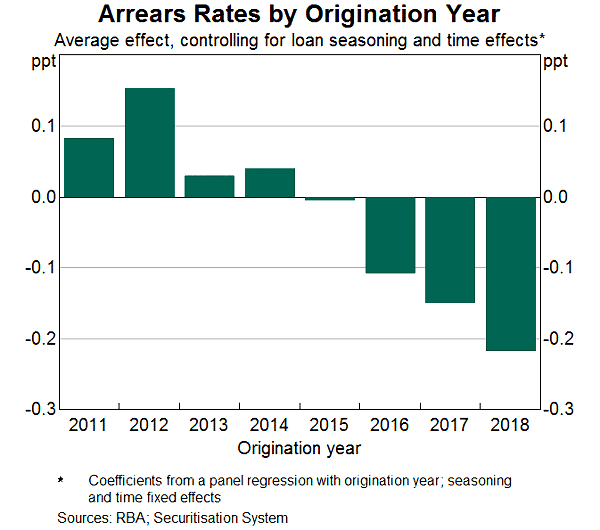
However, in other ways, measures taken to improve lending standards may actually temporarily increase arrears rates. One measure addressed the large and increasing share of loans that were interest only, meaning the borrower was not required to make regular principal payments and so the loan size did not necessarily decline over time. In 2017, APRA imposed a 30 per cent benchmark for the maximum share of lenders' new loans that could be interest only. That benchmark has since been removed. But, recognising the greater risk of interest-only lending, banks continue to charge higher interest rates for these loans and more carefully scrutinise their suitability for borrowers. As a result, some borrowers who may have anticipated being able to roll over an interest-only period are finding they cannot. Some are then facing temporary difficulty servicing the higher principal and interest (P&I) payments at the end of the interest-only period. However, most borrowers in this position get their repayments back on track within a year.
Tighter lending standards have made it more difficult for some borrowers to refinance their loan. In general, a borrower who, say, experienced a decline in their income may be able to reduce their repayments by refinancing with a loan that is at a lower interest rate or has a longer term and so lower repayments. But borrowers who are financially stretched are more likely to be constrained by tighter borrowing restrictions. If they can't refinance and struggle to make their existing repayments, they are more likely to fall into arrears.
There have also been some reports that banks have been displaying greater forbearance, that is, allowing loans to stay in arrears for longer. Supposedly, this is in response to a recognition of, and attention on, some past poor lending decisions. However, it seems unlikely that this could explain a significant part of the increase in aggregate arrears. In an environment of falling housing prices, allowing a borrower to remain in arrears for longer would increase the loss that the borrower, and so the lender, is exposed to. This wouldn't seem to be operating in the best interests of the borrower, or for that matter even the lender.
Conclusion
Summing up, housing arrears have risen but by no means to a level that poses a risk to financial stability. Several factors have been interacting to drive the rise in housing arrears. Economic conditions are undoubtedly part of the story. Weak income growth, housing price falls and rising unemployment in some areas have all contributed. But they have not acted alone, interacting with earlier weaker lending standards, and the more recent tightening in lending standards. To the extent that we can point to drivers of the rise in arrears, while the economic outlook remains reasonable and household income growth is expected to pick up, the influence of at least some other drivers may not reverse course sharply in the near future, and so the arrears rate could continue to edge higher for a bit longer. But with overall strong lending standards, so long as unemployment remains low, arrears rates should not rise to levels that pose a risk to the financial system or cause great harm to the household sector.
Endnotes
Thanks to Paul Ryan for assistance. [*]
The long comparison requires the use of non-performing loans which are those that are 90 or more days late on repayments and well collateralised plus any other impaired loans, that is, loans that are otherwise in doubt and the value of the loan collateral is less than the outstanding loan. These data are for household lending which includes housing lending (over 90 per cent) and personal lending. [1]
For a discussion of the causes and consequences of low income growth see Luci Ellis (2019) ‘What's Up (and Down) With Households?’ Address to Housing Industry Association March Industry Outlook Breakfast, Sydney, 26 March. [2]
This tends to be a better option than the lender repossessing it as it involves fewer costs and generally gets a better price. Past liaison by the Bank found that voluntary sales often achieve a 15–20 per cent higher price than mortgagee-in-possession sales. See ‘Box B: Arrears and Repossessions’ Reserve Bank of Australia, Financial Stability Review, September 2007. Available at https://www.rba.gov.au/publications/fsr/2007/sep/box-b.html. [3]
For a list of the major measures taken see RBA (2018) ‘Assessing the Effects of Housing Lending Policy Measures’, Financial Stability Review, October. [4]
Working in the other direction, over time, a borrower's repayment amount generally declines relative to their income as their income grows. This would suggest that the arrears rate would decline for older mortgages. In the data, these effects are also clouded by the fact that better credit quality borrowers tend to make larger excess payments reducing their loan balance and refinancing. [5]
For more recent cohorts of loans, these estimates are less precise as the Dataset contains fewer loans. The estimates in the text are based on panel regressions with time, cohort and seasoning fixed effects. For details on the Securitisation Dataset see Kate Fernandes and Dominic Jones (2018) ‘The Reserve Bank's Securitisation Dataset’ RBA Bulletin, December, and Christopher Kent (2018) ‘Securitisation and the Housing Market’, Address to the Australian Securitisation Forum Conference Sydney, 26 November. [6]
